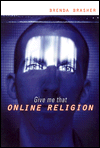
As the Internet weaves its way into so many lives, the likelihood that it is now possible to have a religious experience by going online increases. A decade ago, Brenda Brasher, a professor of religion and philosophy, became intrigued at the way some people have begun to worship at the keyboard and monitor instead of at the church or temple. Give Me That Online Religion (Jossey-Bass, 2001) is the result. Is it really possible to be emotionally engaged in cyberspace to the same extent that one would be moved in a real life situation? Can the Internet move past simple information and actually provide the connectedness that embodies most religious participation? Brasher argues that, while there are certainly limitations – the visitor to the virtual Hindu temple cannot smell the flowers and fruit or interact with the other pilgrims – the Internet also offers the opportunity for people to “visit” places they would never otherwise be able to see. She goes on to postulate that people who use the Internet quickly find that only the mind (that is, the message communicated) is important. As the famous New Yorker cartoon puts it, "On the Internet, nobody knows you're a dog." This is a big shift for traditional religions to make. It is clear that Give Me That Online Religion is one of the first critical forays into the field of religion in cyberspace, and thus it suffers from the errors of early exploration. While the books pioneering contribution is in helping us see the online world as a new context for human activity, one that poses hard questions to traditional religious belief. But because it is a hasty survey of a continent-sized field, it falls short. Chapter by chapter, religion by religion, Brasher describes a number of web sites -- some humorous and possibly profane others beautiful and deeply contemplative. She also talks about several specific people whose online religious activities she has followed. One woman wanted to learn about Judaism in order to decide if she wanted to convert to her boyfriend’s religion. She logged into a “Cyber-Seder,” where she was able to see and hear a Passover celebration, and almost feel like she was a participant. This introduction led her to learn more and understand Judaism’s history, eventually leading her to convert. Another participant in cyber-religion found the homepage for a desert monastery while surfing the Web. He ended up spending a week with these Catholic monks who live in the middle of nowhere in New Mexico. Without the Internet, he never would have found the monastery, which ended up changing his life in many ways. Perhaps it was the chapter on Neo-Pagans (about half way through the book) that convinced me that, in trying to be encyclopedic, she had missed the point. Describing a 'cyberwitch' by the name of Julia as, by turns, contemplative, bored, intrigued, and then devoted to religion online I found myself, an actual cyber witch, irritated and offended. For both the author and Julia, online Paganism begins and ends with MOOs, and the concept of interactive ritual, magick, and traditional teachings within an updated context never arise. Religion is alive and well in cyberspace, but it is not the same old religion. Cyberspace makes possible new forms and expressions of spirituality, from Web pages to e-mail lists to Usenet newsgroups to multiuser chat rooms and beyond. Sacred and profane, orthodox and heretical, authority and parody, all tied together while geographical and other historically clear markers and boundaries are weakened. Give Me That Online Religion provides a good overview of the religious landscape on the Internet. Overall, Brasher believes the good will outweigh the bad, and religious groups must make the move if they are to retain the interest of their followers. I think it this is a good book to own as a reference, but perhaps better as one you get from the library. ~review by Lisa Mc SherryAuthor: Brenda BrasherWiley, John & Sons, 2001
